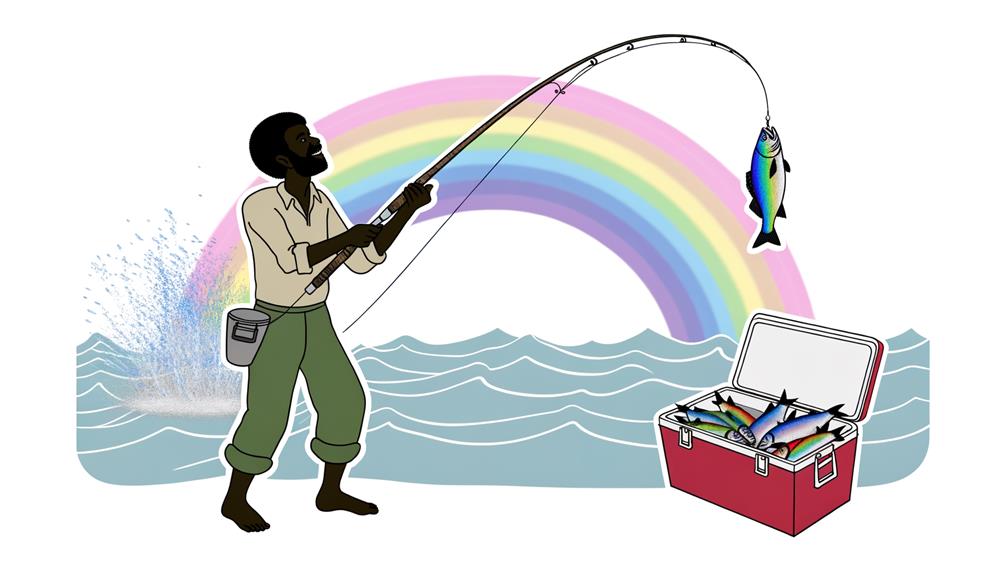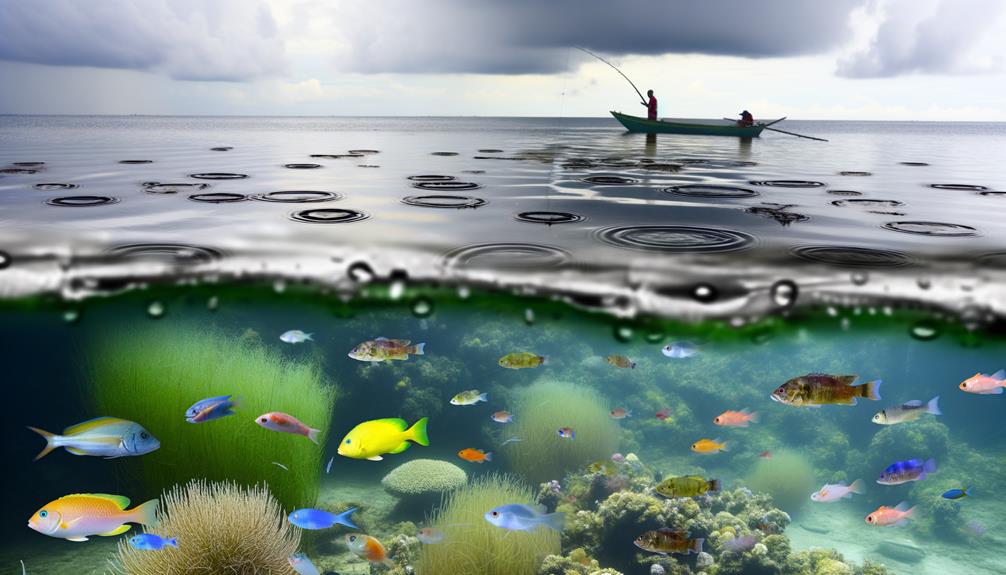The impact of rain on saltwater fishing is a topic of interest for many anglers. While rain can stir up nutrients attracting fish, it can also muddy waters and alter currents, influencing fish behavior and potentially making them harder to catch.
Whether it is beneficial or disadvantageous to fish after rain in saltwater largely depends on various factors such as the intensity of the rain, water temperature, and the species of fish targeted. The discussion invites further exploration into these factors and strategies to improve fishing success in post-rain conditions.
Key Takeaways
- Rain can influence saltwater fishing by altering water clarity, temperature, and salinity, thereby affecting fish behavior.
- After a rain, focusing on runoff areas and using stinky baits can attract fish due to increased nutrient levels in the water.
- Fish may retreat to deeper waters post-rain, hence adjusting fishing depth and tactics can enhance success.
- Monitoring water conditions and timing fishing trips post-rain can significantly improve the fishing experience in saltwater environments.
Understanding Post-Rain Saltwater Fishing
Delving into the realm of post-rain saltwater fishing, it's crucial to understand that this scenario presents unique challenges and opportunities, primarily due to changes in water clarity, temperature, and salinity levels, all of which significantly affect fish behavior.
Rainfall can stir up sediment, creating muddy water that reduces visibility for both the angler and the fish. This turbidity can impact the feeding patterns of fish, necessitating a shift in fishing tactics.
Lowered water temperatures are another outcome of rain, curtailing the activity of certain fish species. Moreover, the dilution of saltwater due to freshwater influx alters salinity levels, affecting the distribution and movement of saltwater fish. These shifts in fish behavior necessitate the use of different lures and bait for effective fishing.
One may find success in cleaning up baitfish or using stinky bait to attract fish in these conditions. Colorful lures may also increase visibility and efficacy. It is these adaptations to changing water conditions and fish patterns that are essential for successful saltwater fishing post-rain.
As part of the fishing community, understanding these dynamics ensures that you can enjoy fruitful fishing, rain or shine.
Weather Conditions Affecting Sea Life
The influence of weather conditions on marine life, particularly post-rain, is a multifaceted phenomenon that significantly alters saltwater ecosystems and fishing dynamics. Rain events can stir up saltwater environments, muddying the water and impacting water clarity. This, in turn, influences fish behavior, potentially reducing their feeding activity and thereby affecting fishing success.
Further, heavy rain upstream can profoundly modify downstream conditions. It alters salinity levels, which can, in turn, affect fish metabolism and feeding patterns. A decrease in water temperature, another consequence of rainfall, can also impact the metabolic rates of marine life, affecting their behavior and the fishing tactics required for a successful catch.
Additionally, post-rain weather conditions can bring about changes in wind direction and intensity. Such shifts can significantly influence fishing conditions in saltwater regions, necessitating adaptability in fishing tactics. To enhance the outcomes of saltwater fishing, it is essential to adjust tactics in response to these changing conditions. Understanding the influence of weather, particularly rain, is crucial for those who seek a sense of belonging in the world of saltwater fishing.
Analyzing Fish Behavior During Rain

In analyzing fish behavior during rain, it is crucial to understand that rain significantly impacts the activity levels and feeding patterns of various species.
The influx of insects into the water due to rainfall can lead to increased feeding activity, while the turbidity caused by rain can inhibit fish movement.
Consequently, understanding these behavioral shifts can enable anglers to modify their strategies for optimum results post-rain.
Rain Impact on Fish
Understanding fish behavior during rain is critical, as it can significantly influence their activity levels, feeding patterns, and overall willingness to bite. It's also important to understand how various fish species react to rain, as this can dramatically affect the prospects of a successful saltwater fishing trip.
Three main factors contribute to the impact of rain on fish:
- Lowered water temperature can affect fish metabolism, potentially reducing their activity levels.
- Increased oxygen levels due to rain can sometimes improve fishing conditions in saltwater environments.
- Heavy rain can muddy the water, impacting fish visibility and, consequently, their willingness to bite.
Thus, the rain's effect on saltwater fishing is multifaceted and depends on several variables.
Post-Rain Fish Activity
Analyzing fish behavior after a rain event reveals intriguing changes in activity levels, feeding patterns, and movement, largely influenced by the intensity of rainfall and the subsequent conditions it creates in the saltwater environment.
Post-rain, some species become more active, lured by the increased availability of food as rain washes insects and organic matter into the water. This heightened fish activity is an adaptation to the feeding opportunities presented by the fresh influx. However, the murky water can pose visibility challenges for the fish, potentially influencing their feeding patterns.
Hence, understanding these behavioral shifts can provide valuable insights for anglers, enabling them to adapt their strategies to the post-rain conditions for a successful fishing experience.
Pros and Cons of Rainy Fishing
Weighing the pros and cons of fishing after a rainfall in saltwater environments can be a nuanced affair, as various factors such as water temperature, oxygen levels, visibility, and weather conditions play significant roles in determining the success rate. Among the advantages, fish often become more active due to the lower water temperature and increased oxygen levels. These conditions may enhance the effectiveness of your bait, leading to a more fruitful outing.
However, there are also downsides to consider, including:
- Rain can stir up sediment, muddying the water and affecting visibility, which can discourage fish from biting.
- The impact of heavy rain and wind direction can alter fish behavior and location, potentially reducing your chances of success.
- The need to adapt tactics and strategies to changing conditions can pose challenges, particularly for less experienced anglers.
Successful Strategies for Post-Rain Fishing

Successful fishing after rain in saltwater requires a strategic approach. The key to this strategy lies in understanding the altered water conditions, selecting appropriate bait, and planning your fishing trip at the right time.
Implementing these strategies can enhance the likelihood of a successful catch in post-rain saltwater environments.
Understanding Water Conditions
In the realm of post-rain saltwater fishing, a clear understanding of water conditions, including clarity and salinity levels, is paramount for determining the likelihood of a successful catch. This is crucial as water clarity directly impacts fish activity levels, thus affecting fishing strategies.
Post-rain conditions often present unique challenges that necessitate keen understanding and strategic adaptation:
- Observing how rain affects water clarity, which in turn can influence visibility for fish and their feeding habits.
- Monitoring how precipitation impacts salinity levels, potentially altering fish behavior and distribution.
- Adjusting fishing strategies according to changes in water temperature, which might affect fish activity levels.
Choosing the Right Bait
Given the significant impact of water conditions on post-rain saltwater fishing, the choice of bait and strategic alterations in fishing techniques become instrumental in improving the likelihood of a successful catch.
Bait fishing, particularly with stinky bait or chum, can attract fish struggling to find food in stained waters. Bright-colored lures can increase visibility in clear waters, while pearl lures are versatile in various water conditions.
Top-water flies, baits, or lures are effective in clear water, and darker colors like Red Shad or Pumpkin enhance success in dirty water. Adjusting fishing depth and targeting calmer areas post-rain also contribute to better catches.
Therefore, choosing the right bait and adopting adaptable strategies are key to successful post-rain saltwater fishing.
Timing Your Fishing Trip
Mastering the art of timing one's fishing trip post-rain is crucial in saltwater fishing, as this period often stimulates heightened fish activity and feeding, thereby increasing the chances of a successful catch. A successful angler is one who understands the nuances of the marine ecosystem, and how changing water conditions can affect fish behavior.
The following strategies should be considered when timing your fishing trip:
- Monitoring the water temperature: Fish are sensitive to temperature changes, so warmer water after rain could indicate increased fish activity.
- Checking the water clarity: Muddy or cloudy water can attract certain fish species.
- Focusing on runoff areas: These zones often attract fish due to the influx of nutrients from the land.
Understanding these factors can make your post-rain fishing trip a success.
Impact of Rain on Saltwater Habitats

Rainfall has a significant impact on saltwater habitats, often resulting in muddy conditions that can affect fish bite and pose challenges for fishing. Heavy rain upstream can lead to excessive freshwater runoff, altering the salinity of bays and coastal areas. This change in water composition can cause fish to become disoriented, and they often retreat to deeper water in search of stable conditions. Consequently, this may increase your chances of locating larger species that generally reside in these depths.
The decrease in water temperature post-rain can deter some fish species, yet it can also increase oxygen levels in the water. This oxygenation sometimes improves the overall fishing conditions, revitalizing the aquatic ecosystem and promoting increased fish activity. Therefore, adapting to these changing conditions is crucial for successful saltwater fishing.
If saltwater conditions are poor, considering freshwater fishing as an alternative after rain may prove beneficial. Understanding the impact of rain on saltwater habitats is essential for any angler seeking to optimize their fishing experience, regardless of the weather. Empowered with this knowledge, you can better navigate the challenges and opportunities presented by post-rain fishing scenarios.
Choosing the Right Bait After Rain
While understanding the impact of rain on saltwater habitats is important, selecting the appropriate bait after rainfall is equally critical to ensure a successful fishing experience. When the rain starts, the water becomes murky and the fish's vision is compromised. This is when it becomes beneficial to use stinky, or strong-scented, baits to attract fish that are relying more on their olfactory senses than their vision.
In this situation, consider the following options:
- Natural baits like shrimp, squid, or mullet, which release a strong aroma into the water.
- Artificial baits designed to mimic injured or struggling prey. These are excellent for drawing attention in the discolored water post-rain.
- Live bait such as pilchards or pinfish which naturally emit their scent and movement, making them irresistible to nearby predators.
Another key consideration is bait size. After the rain, fish tend to be less cautious and more opportunistic, making larger baits more attractive. However, remember to adjust the bait size and presentation based on water clarity and the target species' feeding behavior. This will help to create a more effective and rewarding fishing experience after rain in saltwater environments.
Frequently Asked Questions
Is Salt Water Fishing Good After Rain?
Saltwater fishing post-rain can be productive, though challenging. The rain impact alters weather patterns, affecting fish behavior and bait choices. Success often depends on understanding these changes and adapting fishing strategies accordingly.
Do Fish Bite Better After Rain?
Yes, fish do tend to bite better after rain. Rain influence alters weather patterns, stimulating increased activity in fish. However, successful fishing also requires strategic bait selection, adapting to post-rain water conditions.
What Do Saltwater Fish Do When Raining?
How does rain influence fish behaviors in saltwater environments? Rain significantly alters their habits, with some seeking shelter while others feed more aggressively. Understanding these adaptation mechanisms can enhance the angling experience.
What Time Is Fishing the Best?
The best fishing times are influenced by tidal activity, moon phases, and seasonal patterns. Fish activity increases during high tides, full or new moon phases, and specific seasons, enhancing the likelihood of a successful catch.
Conclusion
In summation, post-rain saltwater fishing presents a unique blend of challenges and opportunities. An in-depth understanding of post-rain weather conditions, fish behavior, and the judicious selection of bait can significantly enhance the fishing experience.
While the rain-induced murkiness might present a temporary setback, the influx of nutrients and increased fish activity may well tip the scales in the angler's favor. Therefore, it may be concluded that fishing after rain in saltwater is indeed a promising endeavor, provided the right strategies are employed.


